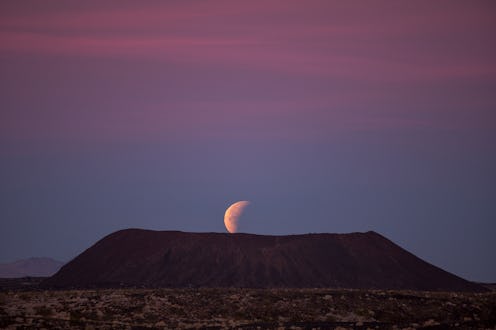
The year has barely started, and already it feels like we've had more than our fair share of lunar events. January gave us two full moons (also known as a blue moon), as well as the very rare super blue blood moon. The fact that there's no full moon in February at all is an event in itself (it's known as a dark moon). And now, on top of all that, there's a pretty big solar event happening this week. On Feb. 15, we'll get our first partial solar eclipse of the year. If you remember the full eclipse from this past summer, you might also remember the warnings to keep your naked eyes away from the sun. It makes people wonder: is it safe to go outside during a partial solar eclipse?
It may be obvious from the name, but it's important to point out that a partial solar eclipse isn't the same as a full solar eclipse. A partial solar eclipse happens when the moon, the sun, and the Earth don't align in a perfectly straight line. When this happens, the moon casts only the outer part of its shadow (also known as the penumbra) onto Earth. To those of us down on the planet, it can look like you only see part of the sun, like the moon has stolen a little piece of it. Partial eclipses can vary in how they look — sometimes they can almost seem like a full eclipse, while other times they're very slight.
Since the moon hasn't passed directly over the sun, a partial eclipse doesn't block as much of the sun's light as a total eclipse will. It doesn't get as dark as outside as it did during the total eclipse this past August. Partial solar eclipses also aren't that rare. In fact, this isn't the only time one is happening in 2018 — we can also expect to see one in July and August, and then again in the very beginning of 2019.
That said, one thing remains the same between the two: you shouldn't be looking directly at them. Time says, "You should never look directly at a partial solar eclipse, since the sun is still visible and can damage your eyes. The only safe way to look at a partial solar eclipse is through eclipse glasses." So the good news is that if you bought a pair of eclipse glasses to view the total eclipse, you can get some more use out of them!
You can, however, go outside during a partial eclipse. You can go outside during a total eclipse as well! The sun may be strong, but it's not going to burn your skin off or do anything crazy like that. The only thing you don't want to do is stare directly at it without wearing eclipse glasses. It may not be as strong as a total eclipse, but is it really worth taking your chances?
Another thing to take note of is that this partial eclipse is happening in the middle of the winter, as opposed to a bright, sunny summer day. There's a good chance it's going to be relatively cloudy outside, meaning that your chances of noticing even the partial eclipse are slim. And while you can certainly go outside as much as you need to on February 15, let's be honest: don't you kind of want an excuse to stay in since it's been so cold and gloomy outside? No judgement here!
In all seriousness, though, feel free to go about your daily business during a partial solar eclipse. Just don't look directly at the sun — which, I'm sure, is something you avoid doing anyway.